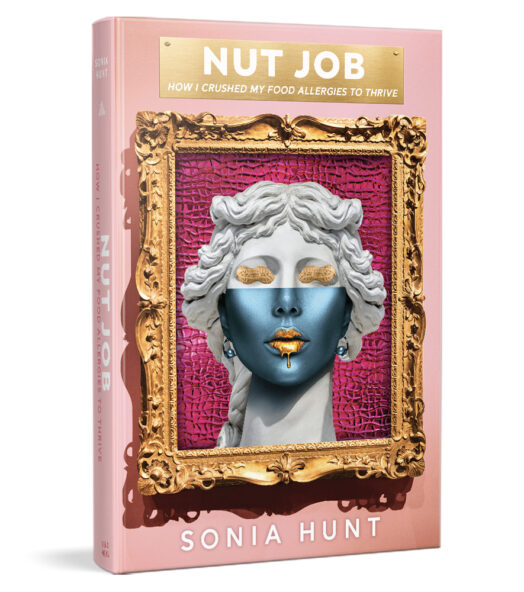My Book

Why I Wrote this Book
This book is a compilation of four decades of trauma and drama, living with severe food allergies, asthma, and environmental allergies. For years I never openly spoke about my health issues, or what I was dealing with until it was almost over one fateful night. I wrote this book to release myself from that trauma and drama, and for everyone on their own journey with chronic health conditions to empower you, inspire you, and make you laugh.
Since I was first diagnosed at age 3, I primarily followed a Western protocol which included not eating the food that I was allergic to (sounds to easy, huh?) and taking strong medications to suppress my symptoms.
Additionally and over decades, I did OIT (oral immunotherapy) and allergy desensitization shots and took antihistamines and other medications to hopefully help my body gradually desensitize, or tolerate, a food allergen.
Unfortunately, none of these methods worked for me, and in 2008 after my 4th time in anaphylaxis and near death, I had to find a new way.
Read my book to find out how I eliminated ALL of my severe food allergies!
What You'll Learn
- Why working on whole-body health is the only way to heal food allergies and chronic health conditions.
- Why your mental health is the most critical component to making conscious decisions around food allergies.
- How to identify the microsteps to remove the toxicity within you.
- How to overhaul your relationship with food and dining.
- Why humanizing your food allergies with the world will set you free.
Read an Excerpt
I’ve almost died four times in my life. Nothing heart-stopping like a heart attack, nor psychotic like being shot. Not even bone-crushing like being hit by a car. Each time, the cause of my near death was the juiciest culprit of them all: food. I am one of over 32 million Americans with severe food allergies. I was first diagnosed with a peanut and tree nut allergy in the late 1970s around the age of three. The icing on my nut-free cake was that I was also diagnosed with severe environmental allergies, and the cherry on top was an asthma diagnosis. The triple threat I always wanted was to be smart, beautiful, and rich, not this whack. My immigrant parents hailed from India and had never heard the words “food allergy” before. “How could somebody be allergic to food?” they would ask my doctors in their cute Indian accents. “Food is supposed to nourish our bodies, not be deadly.” With my diagnosis, I became the broken child amongst siblings who did not share my health issues. Lucky me!
As a child, I was constantly in and out of the hospital, either because of food-allergy reactions, asthma-related incidents, or the severe nosebleeds that were a byproduct of my environmental allergies and a bad habit of picking my nose. My childhood was supposed to be all about playing in a sandbox with friends, not about being allergic to the sand itself! A team of medical professionals became my family’s best friends, as we’d see them often to treat my various ailments. My recommended treatment options were a slew of Western prescription medications, immunotherapy in the form of desensitizing allergy shots, and a list of over-the-counter medications—all with harsh side effects. As a family, we were at the mercy of the medical team and the treatment options they recommended seeing as we didn’t really know much about my triple diagnosis. Nor did my parents know anyone with food allergies, and in the 1970s, there was no Internet and no WebMD.com to research a diagnosis. There wasn’t even a Dr. Oz Show kind of television segment about food allergies, so we followed the lead of my doctors. I became what felt like a poster child for allergies and asthma.
Each one of my health diagnoses was related to the other. For example, some airborne substances can trigger allergy or asthma symptoms, and data from the Journal of Environmental and Public Health shows that “...an increased urbanization (in the United States) contributes to the environment-food allergy nexus”. Environmental allergies are an immune response to something in a person’s surroundings that’s typically otherwise harmless. Well, my list of environmental allergies at the time included dust mites, pollen, trees, mold, and cigarette smoke—all things I was subjected to in the city of Philadelphia, where I grew up. Asthma (which is closely linked to severe reactions to food allergies) is an inflammatory condition of the airways that affects breathing. According to the Asthma and Allergy Foundation of America, “For some people, there may be an indirect connection between food and asthma. Food is not a common asthma trigger. But asthma can be affected by eating. Asthma can also affect how you react if you have food allergies”. So, my triple threat became three times as hard to manage.
You’re probably thinking, “Damn, this girl is a mess!” You would be correct. And I won’t lie—for years, I was the sole guest at my own ultimate and most awesome pity party. It was fun while it lasted and allowed me to wallow in my misery. But once the party was over, I emerged feeling like a loser, which is how I proceeded to see myself for decades because of my health issues. Yet on the outside, I still projected a happy-go-lucky soul.
In my lifetime, I’ve been to the emergency room 18 times due to my food allergies and four times in a full anaphylaxis condition: twice during childhood, once in college, and the last time in 2008. Those numbers don’t include the numerous other visits to the emergency room due to severe nosebleeds and other issues related to my environmental allergies and asthma. My allergic reactions have varied from situation to situation and have included swelling of my lips, tongue, and throat; hives; itchy skin; stomach pain; and shortness of breath. When my stomach hurt or my throat was itching, it was easy to grin and bear it. But the minute I started looking like Will Smith in Hitch, I was out the door.
As the wonderful humans they are, my mom and dad pushed my doctors to understand why this was happening and how we could get rid of it quickly and for good. In the 1970s, there was little data on the causes of food allergies, and that situation has not changed much today. However, some hypotheses have emerged over the past ten or so years. For instance, according to a 2016 report by the American College of Allergy, Asthma, and Immunology, “...factors such as race, ethnicity, and genetics contribute to allergy development”. Also, research from the National Center for Biotechnology Information shows that “Factors such as hygiene and lack of exposure to microbial factors, composition of the intestinal microbiota, diet, obesity, Vitamin D, and environmental chemical exposure may have contributed to the alarming rise in the rate of food allergies in countries with a Westernized lifestyle”. These are only theories, but researchers are working to collect more data to prove these new hypotheses.
The two main things my parents learned about my food allergies back in the 1970s still held true in 2020:
- There is no cure for food allergies.
- The only way to prevent a reaction is by not eating the food.
Countless people around the world are undiagnosed or self-diagnosed with food allergies. I know many of these people! “While we found that 1 in 10 adults have a food allergy, nearly twice as many adults think that they are allergic to foods while their symptoms may suggest food intolerance or other food-related conditions,” says Dr. Ruchi Gupta, M.D., MPH, from Lurie Children’s Hospital. She is also a professor of pediatrics at the Northwestern University Feinberg School of Medicine. FARE, the Food Allergy Research & Education organization, reports:
- Every three minutes, a food allergy reaction sends someone to the emergency room.
- Each year in the United States, 200,000 people require emergency medical care for allergic reactions to food.
- About 40% of children with food allergies are allergic to more than one food.
- About 40% of children with food allergies have experienced a severe allergic reaction such as anaphylaxis.
- Studies published in 2018 and 2019 estimated that the following number of Americans of all age have convincing symptoms of allergy to the following foods:– Shellfish: 8.2 million
– Milk: 6.1 million
– Peanuts: 6.1 million
– Tree nuts: 3.9 million
– Eggs: 2.6 million
– Finfish: 2.6 million
– Wheat: 2.4 million
– Soy: 1.9 million
– Sesame: 0.7 million - Although allergies to milk, egg, wheat, and soy often resolve in childhood, children appear to be outgrowing some of these allergies more slowly than in previous decades, with many children still allergic beyond age five.
- Allergies to peanuts, tree nuts, finfish, and shellfish are generally lifelong.
In addition to this data, millions of people in the world have food sensitivities or intolerances. The difference between a food allergy and a food sensitivity is the body’s response: with food allergies, the immune system causes the reaction; with food sensitivities, the reaction is triggered by the digestive system. This can lead to symptoms such as intestinal gas, abdominal pain, or diarrhea. The “net net,” as I like to say, is that today it is almost abnormal to not have some form of a food restriction. Data also shows that living in the United States for over ten years may raise the risk of some allergies. Now, that is definitely food for thought!
So, why can’t we get our acts together and figure this out? In 1988, Dr. Patricia Bath invented and patented the Laserphaco Probe, which improved treatment for cataract patients. In the 1990s, the Human Genome Project mapped the physical genes that make up the human body. In 1998, the FDA approved the use of Viagra. (‘Nuff said.) In the early 2000s, stem cell research was just as hot of a topic as HIV cocktails were. In the late 2010s, countless smoke-free laws were passed, HPV vaccines were introduced, and bionic limbs surfaced. And in 2020, several pharmaceutical companies created a COVID-19 vaccine that rapidly went through an Emergency Use process with the FDA. Yet despite the growth rate of food allergies in the US, doctors still don’t know the exact cause of food allergies and we still don’t have a cure for them. WTF? I have often wondered if anyone really cares. Are the over 32 million Americans who suffer not enough? Allergic disease is one of the most common chronic health conditions in the world and is usually considered a disability under the Americans with Disabilities Act.
The number of people with food allergies in the United States continues to rise as time goes on. The Centers for Disease Control and Prevention (CDC) reports that “The prevalence of food allergies in children increased by 50% between 1997 and 2011”. In 2017, CBS News reported that “…approximately four percent of Americans have a food allergy, with women and Asians the most affected”. Uh, hello…I fall into both of those categories! As data has continued to be released over the decades, the alarming rates of food allergies and incidents are often depressing. But I was stuck in my own hell just having to figure out how to survive.
We’ve all read too many stories of a child who eats a piece of food, has an immediate reaction to that food, and doesn’t survive. It is unfathomable, unacceptable, and unconscionable that we still don’t have a handle on food allergies in America.
IT’S TIME TO WAKE UP TO THE FACT THAT FOOD IN THE UNITED STATES IS KILLING US.





